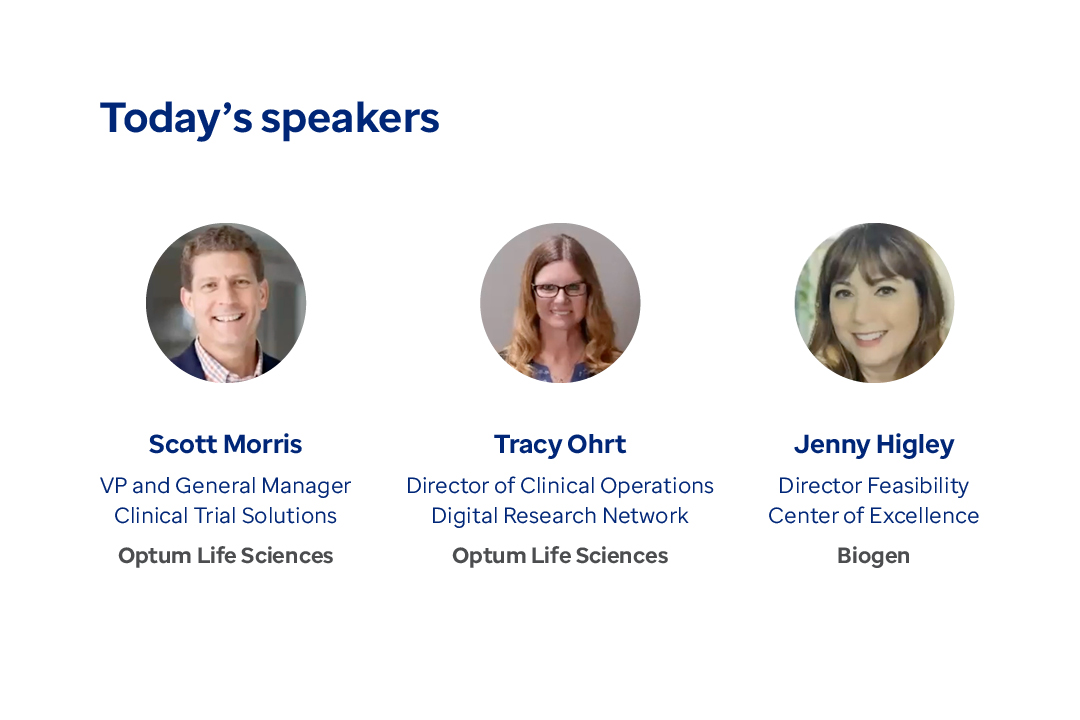Tracy Ohrt
Director, Clinical Operations, Digital Research Network (DRN)
The modern headaches of clinical trial design
You’re probably familiar with the obstacles that hinder successful clinical trials. Many of today's challenges relate to patient recruitment. Finding the right patients in the right places, enrolling those patients, hitting recruitment goals, keeping patients engaged — the list goes on. As a result, 80% of clinical trials fail to meet their participant enrollment rate targets.
And with the shift towards more targeted treatments, clinical trial recruitment is getting even more challenging. Eligibility criteria are more complicated and stringent than ever before.
So, what happens when there are fewer patients eligible for your study than expected? There can be very costly consequences: protocol amendments, delayed milestones or even the premature discontinuation of the clinical trial. No matter the form, you’ve wasted time, money and resources.
In theory, one smart way to avoid recruitment challenges is to assess clinical trial feasibility further upstream, while the research protocol is still being designed. But protocol design and feasibility assessment are often siloed. So, by the time feasibility teams are involved, the protocol is already finalized. Bridging that gap is easier said than done. It requires not only the right tools and data to understand how protocol designs affect feasibility, but also the right forms of team collaboration.
New frontiers in clinical trial design, feasibility and protocol
Clinical trials have incredibly high stakes. And, given the high standards of regulatory bodies around the world, scientific rigor is paramount to their success. But there’s a balancing act at play across multiple priorities here. You want to maintain that scientific rigor while creating and running a trial designed to answer as many questions as possible.
That balance between protocol design and feasibility is crucial in order to have a study that is both scientifically sound and viable, meaning you can actually find and enroll patients who fit the clinical study criteria.
Keep in mind, this is a new era with real-world clinical data. You don’t have to rely on historical data from past clinical trials to conduct feasibility anymore — you can look at real-time electronic health record (EHR) data from health care facilities across the country.
This evolution helps make the case for assessing feasibility before the trial protocol is finalized. When you can analyze granular patient characteristics important to your study from millions of real-time patient records, you can optimize your protocol upfront to simplify recruitment efforts and preserve downstream resources.
Collaborative clinical trial feasibility and design for the win
Bringing feasibility analysis further upstream in the planning process feels more realistic when you have the right tools. That’s where the Optum® Prospector™ Data Mining Studio comes in.
Prospector is a precise protocol modeling and patient-finding tool built on a robust EHR data set with more than 100 million de-identified patient lives across the United States. Within the tool, you can model the effects of inclusion and exclusion criteria to confirm you are looking at a recruitable population, allowing you to pressure test protocols in advance. This way, you can further refine the research protocol before it’s finalized. You can learn more and get an in-depth look at Prospector by watching this clinical trial recruitment webinar.
With access to real-world patient data, study feasibility becomes a more efficient and accurate process that can occur concurrently with clinical trial protocol development. And with Prospector, it can all be done without any coding or programming experience.
Incorporating EHR data in this process provides tremendous value. You can keep it simple with a quick snapshot of a patient population with a certain diagnosis and age range. Or you can get very granular in how you're defining that inclusion and exclusion criteria, filtering by specific diagnosis and procedure codes, medication doses or even specific assays used to perform a diagnostic test. This granularity can enable feasibility teams and protocol design teams to have data-driven conversations evaluating the specifics of how eligibility criteria are defined.
For instance, Prospector lets you look directly at lab values from de-identified, real-world patients to check eligibility based on lab cutoffs in the protocol. Based on what you find, you may decide to make very small protocol changes — for example, adjusting A1C% thresholds — that have the potential to dramatically expand your eligible patient pool.
And even if a protocol is almost finished, or even finalized, Prospector can help you plan for an unexpected drop in eligible patients and mitigate some risks.
The other key value of EHR data is the unstructured physician notes. Optum has a team dedicated to natural language processing (NLP) that takes unstructured information from physician notes and transforms it into a structured, searchable, filterable data set. Those data can then be used for feasibility to get an even clearer picture about individual patient characteristics and who's likely to qualify for a trial.
But what if you want to actually recruit these patients? You can take things a step further and work with vetted research sites through the Optum® Digital Research Network (DRN). The DRN lets you not only identify sites that look like a good fit for your study, but also precisely recruit patients that meet your eligibility criteria from a pool of nearly 40 million patients. You can feel confident that potential trial participants likely meet study criteria because patients are cross-checked against their EHR records.
Start upstream to save time, money and effort
Clinical trial design is a tricky process, and a lot is at stake. There’s no one-size-fits-all approach here. But innovation is crucial to moving the needle and getting patients the treatments they need, faster.
Promoting crossover between the protocol design and feasibility processes can help bring you closer to closing that last mile between your study and the participants. And with the right tools and support from the Optum clinical trial team, collaboration is just around the corner.
Plus, take advantage of this real-world vantage point you have in 2024. Don’t just look at historical data from past clinical trials to conduct feasibility — look at actual real-world data (RWD) from patients today and use that to inform protocol design from the beginning.
Streamline trial protocol and feasibility
Interested in learning more about the value of Optum clinical trial solutions?

Webinar: Solving trial recruitment challenges with data

What if pragmatic trials were more practical?

